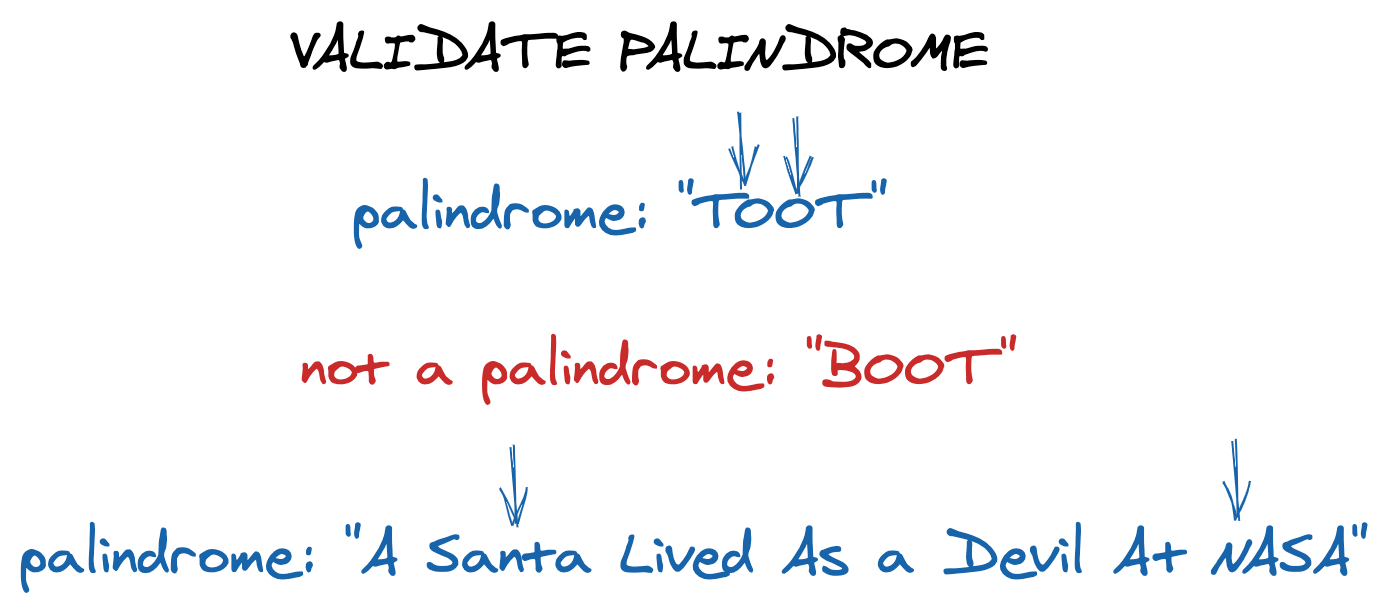Good evening! Here's our prompt for today.
Given a string str, can you write a method that will return True if is a palindrome and False if it is not? If you'll recall, a palindrome is defined as "a word, phrase, or sequence that reads the same backward as forward". For now, assume that we will not have input strings that contain special characters or spaces, so the following examples hold:
1str = 'thisisnotapalindrome'
2is_palindrome = is_palindrome(str)
3# False
4
5str = 'racecar'
6is_palindrome = is_palindrome(str)
7# TrueFor an extra challenge, try to ignore non-alphanumerical characters. The final solution that we present will handle all edge cases.
Constraints
- Length of the given string <=
100000 - The string will consist of ASCII characters (some or all)
- Expected time complexity :
O(n) - Expected space complexity :
O(1)
Try to solve this here or in Interactive Mode.
How do I practice this challenge?
xxxxxxxxxxdef is_palindrome(s): # fill in return True# print(is_palindrome('A Santa Lived As a Devil At NASA'));import unittestclass Test(unittest.TestCase): def test_1(self): assert is_palindrome("A Santa Lived As a Devil At NASA") == True print( "PASSED: assert is_palindrome('A Santa Lived As a Devil At NASA') == True" ) def test_2(self): assert is_palindrome("gold") == False print("PASSED: assert is_palindrome('gold') == False") def test_3(self): assert is_palindrome("a") == True print("PASSED: assert is_palindrome('a') == True") def test_4(self): assert is_palindrome("racecar") == True print("PASSED: assert is_palindrome('racecar') == True")Tired of reading? Watch this video explanation!
To change the speed of the video or see it in full screen, click the icons to the right of the progress bar.

We'll now take you through what you need to know.
How do I use this guide?
Let's test your knowledge. Is this statement true or false?
A string is defined as a palindrome if the reversal of the string is equal to the original string.
For example, “toot” is a palindrome, but “boot” is not.
Press true if you believe the statement is correct, or false otherwise.
This is a classic question, and there are multiple ways to solve this. For the sake of learning, let's cover all of them!
Using built-in methods

This would probably be invalid in an actual interview, but you can rely on the built-in String method to accomplish a quick reversal. In Javascript, you can simply call reverse() and in Python, you can call [::-1] You can then compare the reversed string to the original:
xxxxxxxxxxdef isPalindrome(s): # Calling reverse function reversed = s[::-1] # Checking if both strings are equal or not if s == reversed: return True return Falseprint(isPalindrome("racecar"))Let's test your knowledge. Could you figure out the right sequence for this list?
What's the order of successfully finding out if a string is a palindrome?
Press the below buttons in the order in which they should occur. Click on them again to un-select.
Options:
- Open a while loop to perform while low is less than high
- Continue until end of loop and return true
- Define two variables: high and low, as 0 and (length of string - 1)
- If `string[low]` does not equal `string[high]`, return false. Increment low, decrement high
Let's test your knowledge. Click the correct answer from the options.
What will the following pseudocode do to an input string?
1def reverse_str(str):
2 start = 0
3 end = len(str)-1
4 str_copy = [letter for letter in str]
5 while start < end:
6 temp = str_copy[start]
7 str_copy[start] = str_copy[end]
8 str_copy[end] = temp
9 start += 1
10 end -= 1
11 return "".join(str_copy)Click the option that best answers the question.
- Make a copy
- Reverse the string
- Swap the first and last letters
- Infinite loop
With a while loop:

We can cut down on the number of operations by recognizing that we don't need to do len(str)-1 iterations. Instead of using just one pointer that simply iterates through the string from its end, why not use two?
xxxxxxxxxxdef is_palindrome(str): left = 0 right = len(str) - 1 while left < right: if str[left] != str[right]: return False left += 1 right -= 1 return Trueprint(is_palindrome('racecar'))What we're doing above is specifying two pointers, start and end. start points to the beginning of the string, and end is a pointer to the last character. Taking the example input racecar, as we run through it, these are the comparisons we'll see:
xxxxxxxxxxracecar^ ^racecar ^ ^racecar ^ ^racecar ^TrueAre you sure you're getting this? Click the correct answer from the options.
What is the run time of the following code?
1def reverse_str(str):
2 start = 0
3 end = len(str)-1
4 str_copy = [letter for letter in str]
5 while start < end:
6 temp = str_copy[start]
7 str_copy[start] = str_copy[end]
8 str_copy[end] = temp
9 start += 1
10 end -= 1
11 return "".join(str_copy)Complexity of Final Solution
Let n be the length of the string. We iterate n/2 times until the left pointer is greater than the right pointer for linear O(n) time complexity, and we use a constant O(1) space for the 2 pointers.
Click the option that best answers the question.
- O(log n)
- O(n)
- O(n log n)
- O(n^2)
One Pager Cheat Sheet
- You can write a method using
O(n)time andO(1)space complexity to check if a givenstringof length100000or less is a palindrome, taking into account non-alphanumerical characters. - The
given stringis apalindromeif it reads the same forwards as it does backwards. - With built-in methods, you can easily
reverse()or[::-1]aStringand then compare it to the original to check if it is apalindrome. - By utilizing two variables,
lowandhigh, to represent the starting and ending indices of a string to be checked, and using awhile loopto compare characters at these indices, we can determine if a string is a palindrome or not. - The code reverses a string by looping over the characters, swapping the characters and keeping track of the
startandendindexes using atempvariable, and then joining the characters of thestr_copylist to return the reversed string. - We can reduce complexity by using
two pointersinstead of one and only have to dolen(str)/2iterations of thewhile loopin order to validate if a string is a palindrome. - Comparing characters of a
stringwith two pointers,startpointing to the beginning andendpointing to the last character, the example inputracecarshows us the initial comparisons. - The runtime of the code is
O(n), withO(1)space complexity, wherenis the length of the string, since it iterates linearly with a constant space overhead.
This is our final solution.
To visualize the solution and step through the below code, click Visualize the Solution on the right-side menu or the VISUALIZE button in Interactive Mode.
xxxxxxxxxx print("Nice job, 4/4 tests passed!")import reALPHA_NUMERIC = re.compile("[^a-zA-Z0-9]")def is_palindrome(s): if not s or s == "": return True else: left = 0 right = len(s) - 1 while left < right: left_char = s[left].lower() right_char = s[right].lower() if is_alpha_num(left_char) and is_alpha_num(right_char): if left_char == right_char: left += 1 right -= 1 else: return False else: if not is_alpha_num(left_char): left += 1 if not is_alpha_num(right_char): right -= 1 return Truedef is_alpha_num(c):Got more time? Let's keep going.
If you had any problems with this tutorial, check out the main forum thread here.

